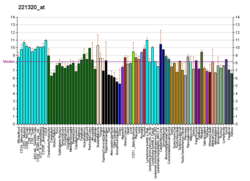BCL2L10
Bcl-2-like protein 10 is a protein that in humans is encoded by the BCL2L10 gene.[5][6][7]
The protein encoded by this gene belongs to the BCL-2 protein family. BCL-2 family members form hetero- or homodimers and act as anti- or pro-apoptotic regulators that are involved in a wide variety of cellular activities. The protein encoded by this gene contains conserved BH4, BH1 and BH2 domains. This protein can interact with other members of BCL-2 protein family including BCL2, BCL2L1/BCL-X(L), and BAX. Overexpression of this gene has been shown to suppress cell apoptosis possibly through the prevention of cytochrome C release from the mitochondria, and thus preventing caspase-3 activation. The mouse counterpart of this protein is found to interact with Apaf1 and forms a protein complex with Caspase 9, which suggests the involvement of this protein in APAF1 and CASP9 related apoptotic pathway.[7]
References
- GRCh38: Ensembl release 89: ENSG00000137875 - Ensembl, May 2017
- GRCm38: Ensembl release 89: ENSMUSG00000032191 - Ensembl, May 2017
- "Human PubMed Reference:". National Center for Biotechnology Information, U.S. National Library of Medicine.
- "Mouse PubMed Reference:". National Center for Biotechnology Information, U.S. National Library of Medicine.
- Inohara N, Gourley TS, Carrio R, Muniz M, Merino J, Garcia I, Koseki T, Hu Y, Chen S, Nunez G (Jan 1999). "Diva, a Bcl-2 homologue that binds directly to Apaf-1 and induces BH3-independent cell death". J Biol Chem. 273 (49): 32479–86. doi:10.1074/jbc.273.49.32479. PMID 9829980.
- Song Q, Kuang Y, Dixit VM, Vincenz C (Feb 1999). "Boo, a novel negative regulator of cell death, interacts with Apaf-1". EMBO J. 18 (1): 167–78. doi:10.1093/emboj/18.1.167. PMC 1171112. PMID 9878060.
- "Entrez Gene: BCL2L10 BCL2-like 10 (apoptosis facilitator)".
Further reading
- van Oirschot JT (1999). "Diva vaccines that reduce virus transmission". J. Biotechnol. 73 (2–3): 195–205. doi:10.1016/S0168-1656(99)00121-2. PMID 10486928.
- Pan G, O'Rourke K, Dixit VM (1998). "Caspase-9, Bcl-XL, and Apaf-1 form a ternary complex". J. Biol. Chem. 273 (10): 5841–5. doi:10.1074/jbc.273.10.5841. PMID 9488720.
- Ke N, Godzik A, Reed JC (2001). "Bcl-B, a novel Bcl-2 family member that differentially binds and regulates Bax and Bak". J. Biol. Chem. 276 (16): 12481–4. doi:10.1074/jbc.C000871200. PMID 11278245.
- Naumann U, Weit S, Wischhusen J, Weller M (2001). "Diva/Boo is a negative regulator of cell death in human glioma cells". FEBS Lett. 505 (1): 23–6. doi:10.1016/S0014-5793(01)02768-5. PMID 11557035.
- Aouacheria A, Arnaud E, Venet S, et al. (2001). "Nrh, a human homologue of Nr-13 associates with Bcl-Xs and is an inhibitor of apoptosis". Oncogene. 20 (41): 5846–55. doi:10.1038/sj.onc.1204740. PMID 11593390.
- Zhang H, Holzgreve W, De Geyter C (2002). "Bcl2-L-10, a novel anti-apoptotic member of the Bcl-2 family, blocks apoptosis in the mitochondria death pathway but not in the death receptor pathway". Hum. Mol. Genet. 10 (21): 2329–39. doi:10.1093/hmg/10.21.2329. PMID 11689480.
- Strausberg RL, Feingold EA, Grouse LH, et al. (2003). "Generation and initial analysis of more than 15,000 full-length human and mouse cDNA sequences". Proc. Natl. Acad. Sci. U.S.A. 99 (26): 16899–903. doi:10.1073/pnas.242603899. PMC 139241. PMID 12477932.
- Li Z, Takeuchi S, Ohara N, Maruo T (2003). "Paradoxically abundant expression of Bcl-2 and adrenomedullin in invasive cervical squamous carcinoma". Int. J. Clin. Oncol. 8 (2): 83–9. doi:10.1007/s101470300015. PMID 12720100.
- Kang Y, Lee DC, Han J, et al. (2007). "NM23-H2 involves in negative regulation of Diva and Bcl2L10 in apoptosis signaling". Biochem. Biophys. Res. Commun. 359 (1): 76–82. doi:10.1016/j.bbrc.2007.05.090. PMID 17532299.
- Guillemin Y, Lalle P, Gillet G, et al. (2009). "Oocytes and early embryos selectively express the survival factor BCL2L10". J. Mol. Med. 87 (9): 923–40. doi:10.1007/s00109-009-0495-7. PMID 19551325.
External links
- BCL2L10 human gene location in the UCSC Genome Browser.
- BCL2L10 human gene details in the UCSC Genome Browser.




